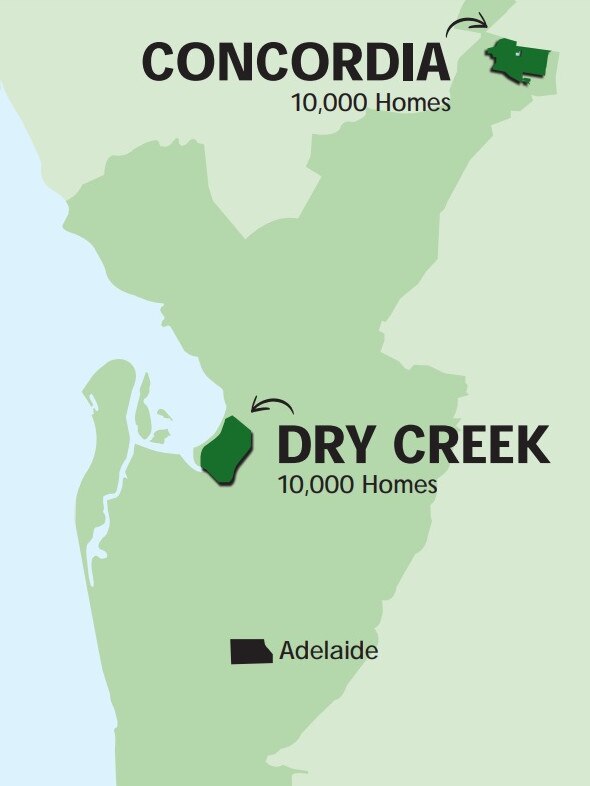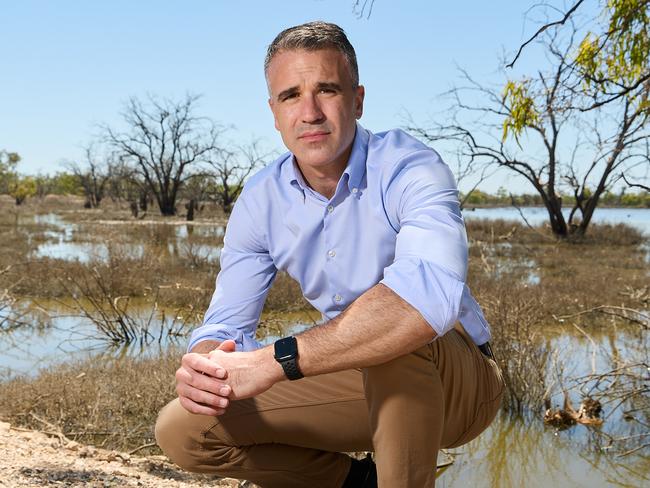Mali’s big build: Premier targets outer-suburban growth with 24,000 new homes in four major land releases
Almost 24,000 extra homes for more than 50,000 people are set to be delivered in four residential land parcels, as the Premier declares urban sprawl is “not a dirty word”. See the plans.
SA News
Don't miss out on the headlines from SA News. Followed categories will be added to My News.
The largest single release of residential land in the state’s history will kickstart a government plan to trigger almost $1bn worth of home construction and tackle an unprecedented housing crisis.
At least 23,700 extra homes for more than 50,000 people are set to be delivered in four land parcels, with construction expected to start next year and at least 15 per cent earmarked for affordable housing.
The land release comprises parcels for 10,000 homes each at Dry Creek and Concordia (on Gawler’s northeastern fringe), at least 2000 homes at Hackham and 1700 at Sellicks Beach.
In an interview with the Sunday Mail, Premier Peter Malinauskas insisted urban sprawl was not “a dirty word”, declaring urban and economic growth “underpins the ability for young families to be able to enjoy the great Australian dream” of home ownership.
By contrast, he condemned “clogging up suburban neighbourhoods with ever more infill” and declared he did not “believe in urban infill at all costs”.


Deliberately highlighting a “point of difference” with his Labor predecessor Jay Weatherill, Mr Malinauskas declared he was “in favour of population growth” supported by effective roads, schools and other infrastructure.
“The state is growing. Our population is heading up and we know that in terms of economic growth, we’re pretty bullish about our prospects going forward,” Mr Malinauskas said.
“We’ve got a good base but with everything we expect to occur around key industries like defence, space, cyber and decarbonisation, we are going to need more homes. Plain and simple.”
Mr Malinauskas said surging interest rates intensified the urgency for government intervention to spur change in the housing market – the monthly payment on a typical $500,000 mortgage has soared by almost $1000 since April.
The accelerated land release, in areas within the urban growth boundary, will be underpinned by the formation of an Infrastructure Planning and Development Unit charged with co-ordinating electricity, water, sewerage, roads, schools and other infrastructure.
This will involve the striking of deeds, or agreements with developers, for infrastructure and community facilities before land is rezoned for housing.

“My assessment is that a majority of South Australians are comfortable with the idea of population growth, provided the requisite investments have been made in infrastructure: road infrastructure, transport infrastructure, health infrastructure, education infrastructure,” Mr Malinauskas said.
“There’s also a more finite degree of detail that makes a difference too – that’s simple things like connection to power supply and SA Water, which a lack of co-ordination around has actually been an inhibitor towards the development of rezoned land.
“Population growth means economic growth, and economic growth grows the ability of the state to be able to provision for these things in the budget.”
Mr Malinauskas said he wanted housing to remain affordable but also an attractive investment, embracing opportunity for young people and encouraging them to stay in or return to the state.
The land release is expected to be more than double the number of allotments released in Mount Barker in 2011 and four times the number released at Mawson Lakes about 20 years ago.
Mapped: The new developments
Asked whether he was effectively burying the Weatherill government's pivot to urban infill development, Mr Malinauskas said this had a place, particularly in brownfield, or former industrial sites.
“But clogging up suburban neighbourhoods with ever more infill, without any reference to what it does to streets, what it does to neighbourhoods, isn’t always good. I don’t believe in urban infill at all costs,” he said.
“It has never sat well with me that urban sprawl has been denounced as a dirty word. Thought-through urban growth provides affordable land for young South Australian families to actively choose that they want a house with a yard. Now what is wrong with that?
“If we completely curtail urban growth, then we’re confining young South Australian families to having to live in ever-denser living environments, and then their children don’t get the benefit of having the ability to play or enjoy a backyard at home.
“I don’t believe that having an unattached home with a backyard should only be accessible to high-net-worth individuals. And this is important, because the active curtailing of urban growth, or talking about urban growth as urban sprawl and it’s all bad, I think is unfair on young aspirational families who want to be able to enjoy the same standard of living as they had when they grew up.”
Property Council research released on February 8 showed 81 per cent of Australians believed there was a lack of affordable housing supply in their area.
Mr Malinauskas told the Sunday Mail this was the first stage of a housing package, developed by key ministers including Treasurer Stephen Mullighan, that would take immediate and long-term action to support about $965m of extra construction.
At an Advertiser Housing Forum last September, Mr Mullighan declared Adelaide must pursue an aggressive growth strategy to double the CBD population, which should include conversion of old office buildings into housing.
We need more South Aussies: Premier
Premier Peter Malinauskas is backing population growth for the state, warning younger families will pay the price of providing government services unless the economy expands.
Outlining the case for growing the state, Mr Malinauskas told the Sunday Mail population growth spurred economic growth, which swelled state finances and the ability to pay for health, education and other government services.
“Think about the counterfactual – we can’t afford not to (grow the population). If we aren’t growing the pie, then everyone will pay the price, particularly amongst younger families,” he said.
“We have got an ageing population. The explosion of demand on, say hospital services, is because more people are getting older and when they get older, they need more access to healthcare.
“Now there needs to be a workforce that underpins generating economic activity, which creates income for government to be able to pay for looking after people.”
Asked whether he backed a population target, such as the two million by 2030 proposed last February by the-then Committee for Adelaide chief Bruce Djite, Mr Malinauskas declined to set a figure.
“I’m less interested in arbitrary numbers than the policy that will actually underpin the growth in a way that is supported by South Australians,” he said.
Mr Malinauskas said growing the complexity and size of the state economy increased the government’s tax base.
“Improving economic complexity means people are going up on the value chain of wages, and the more they earn the better their standard of living, but it also derives the benefit of improving revenues for government to invest in critical social infrastructure,” he said.
Asked about federal government projections of the return of a so-called brain drain, or a net loss of people from SA through interstate migration, Mr Malinauskas said the state had to aspire to mitigate that as best it could.
This trend reversed for the first time since 1990-91 during the height of the Covid-19 pandemic and the federal Centre for Population projects an inflow until 2023-24, when net interstate migration of -3500 is forecast.
“It was self-evident that closing the borders resulted in a change. We hope that that change has a lasting impact, in terms of the way people contemplate living and working in a place like South Australia,” Mr Malinauskas said.
“Ultimately, I think the best policy that we can pursue to address that is an economic growth policy and an industrial expansion policy, because it’s the work that drives people’s behaviours more than anything else.
“But this is a key part of the equation, because, relatively, growth in price in South Australia has been more recently higher than we’ve seen in the eastern states, so we don’t want our relative advantage of affordability to be diminished, which would undermine our capacity to see those numbers going in the right direction.”
More Coverage
Originally published as Mali’s big build: Premier targets outer-suburban growth with 24,000 new homes in four major land releases





